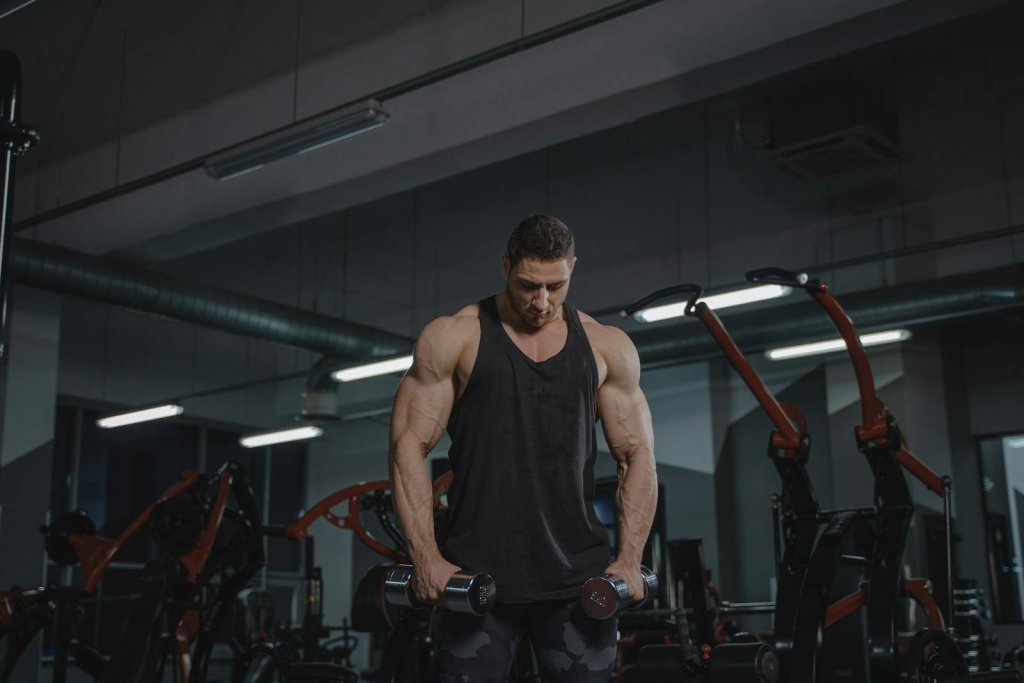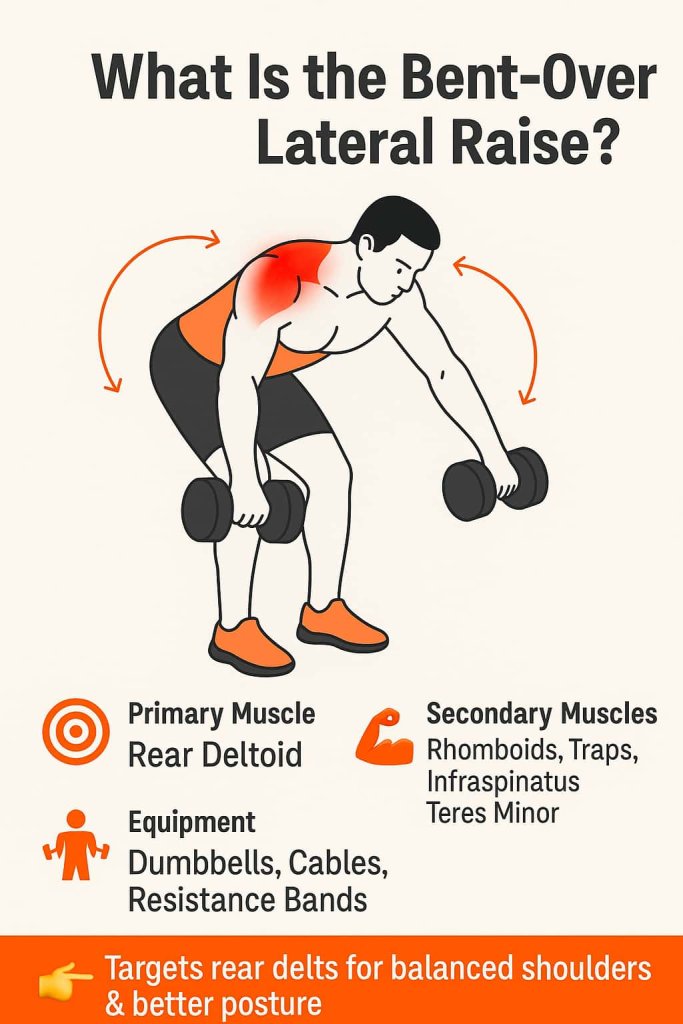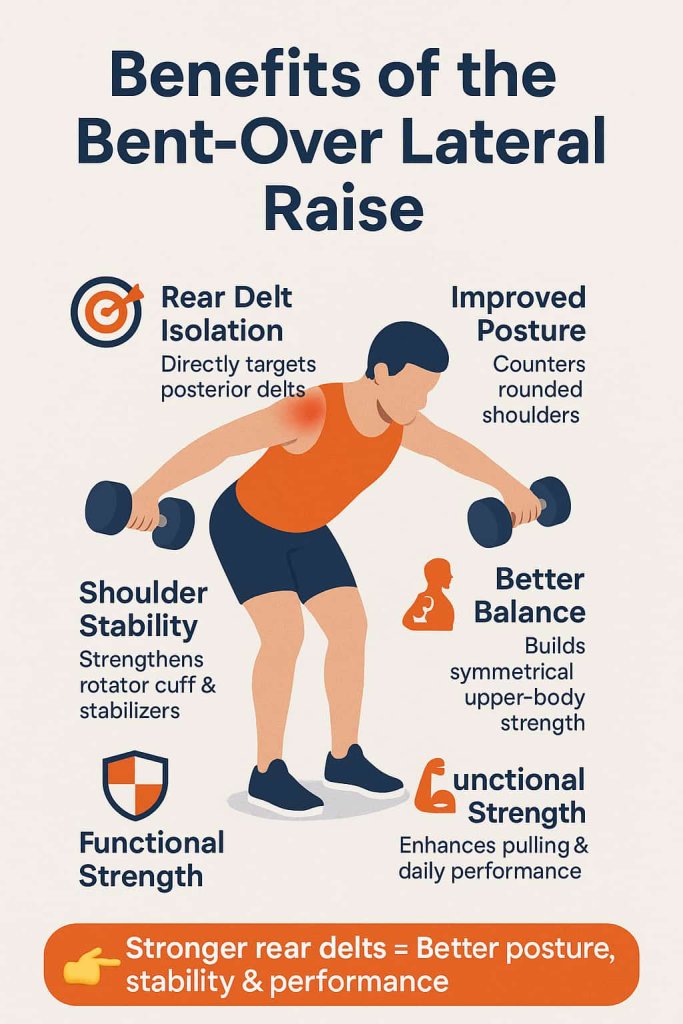The bent-over lateral raise is one of the best isolation exercises to build and strengthen your rear deltoids.
It directly targets the posterior shoulder muscles while also engaging your traps and rhomboids for better posture and upper-back balance.

Understanding this exercise is important because rear delts are often undertrained compared to front and side delts, which can lead to rounded shoulders, imbalances, and injury risks. With proper form, the bent-over lateral raise helps correct posture, enhance pressing strength, and build a complete, balanced physique.
In this guide, you’ll learn correct form, benefits, common mistakes, variations, and tips for maximizing activation.
What Is the Bent-Over Lateral Raise?
The bent-over lateral raise—also called the rear delt raise or reverse fly—is a dumbbell shoulder exercise.

It is performed by hinging at the hips, leaning forward, and lifting weights out to the sides to isolate the rear deltoids.
- Primary Muscle Worked: Posterior (rear) deltoid
- Secondary Muscles: Rhomboids, middle trapezius, infraspinatus, teres minor, and erector spinae (for stability)
- Equipment Needed: Dumbbells, cables, or resistance bands
👉 According to Healthline (2025), this move not only improves shoulder definition but also supports joint stability and postural health.
Benefits of the Bent-Over Lateral Raise

1. Rear Delt Isolation
Unlike overhead pressing, this exercise directly targets the posterior delts, helping fix imbalances between the front and rear shoulders.
2. Improved Posture
By strengthening rear delts and upper back, it combats rounded shoulders common from sitting or pressing-heavy workouts.
3. Shoulder Stability
The exercise engages the rotator cuff and scapular stabilizers, reducing injury risks during presses and pulls.
4. Better Upper-Body Balance
Balances front, side, and rear delts for a well-rounded physique and stronger athletic performance.
5. Functional Strength
Stronger rear delts improve pulling strength and performance in sports, rows, and everyday movements.
How to Do the Bent-Over Lateral Raise (Step-by-Step)
- Setup
- Stand with feet hip-width apart.
- Hold dumbbells with a neutral grip (palms facing each other).
- Slightly bend your knees.
- Hinge at the Hips
- Push hips back and lean torso forward (30–45° or nearly parallel).
- Keep back flat and core braced.
- Starting Position
- Let arms hang straight down under shoulders.
- Maintain a small bend in elbows.
- Lift the Weights
- Raise arms out to the sides until upper arms are parallel to the floor.
- Lead with elbows, not wrists.
- Squeeze & Lower
- At the top, squeeze shoulder blades together.
- Slowly lower weights back to start under control.
✅ Pro Tip: Keep hands slightly below elbows at the top to avoid trap dominance.
Common Mistakes to Avoid
- Using Too Much Weight → Causes swinging, poor isolation.
Fix: Use lighter dumbbells for strict control. - Rounding the Back → Increases injury risk.
Fix: Keep spine neutral with a proper hip hinge. - Shrugging Shoulders → Shifts work to traps.
Fix: Keep shoulders down and retract shoulder blades. - Overextending Arms → Lifting too high reduces rear delt tension.
Fix: Stop when upper arms are parallel to the floor. - Using Momentum → Removes tension from delts.
Fix: Perform slow, controlled reps with 2–3 second lowering.
Programming: Sets, Reps & Frequency
- Hypertrophy (muscle growth): 3–5 sets of 8–12 reps
- Endurance & activation: 2–3 sets of 12–20 reps (lighter weight)
- Frequency: 1–2 times per week on pull or shoulder day
👉 The trainer suggests using moderate loads while maintaining strict form to maximize rear delt activation.
Variations of the Bent-Over Lateral Raise
The bent-over lateral raise is one of the most effective isolation exercises for targeting the rear deltoids (posterior shoulders). Since rear delts are often underdeveloped compared to the front and side delts, using variations can help maximize growth, improve posture, and balance shoulder strength. Below are four key variations to try:
1. Seated Bent-Over Raise
How to do it:
- Sit on the edge of a flat bench, feet flat on the ground.
- Hold dumbbells at your sides with palms facing each other.
- Hinge forward at the hips until your chest is just above your thighs.
- With a slight bend in the elbows, raise the dumbbells out to the sides until they reach shoulder height.
- Lower slowly with control.
Benefits:
- Reduces lower back strain compared to the standing version.
- Enforces stricter form since you can’t use momentum as easily.
- Great for beginners or those with back issues.
Trainer Tip: Exhale as you lift, and pause briefly at the top to feel the contraction in your rear delts.
2. Incline Bench Reverse Fly
How to do it:
- Lie face down on an incline bench set at a 30–45° angle.
- Hold dumbbells below your shoulders with palms facing each other.
- Keeping elbows slightly bent, raise arms out to the sides in a wide arc.
- Slowly lower back down.
Benefits:
- Provides chest support, reducing stress on the lower back.
- Minimizes momentum, forcing your rear delts to work harder.
- Allows heavier loads with good form since the bench stabilizes your body.
Trainer Tip: Keep your neck neutral (don’t crane upward). Think about pulling with your rear delts, not your traps.
3. Cable or Band Rear Delt Raise
How to do it:
- Stand in the middle of a cable machine or use a resistance band anchored at ankle height.
- Hold the cable handles (or band ends) in opposite hands so they cross in front of you.
- Bend forward slightly at the hips.
- With elbows soft, raise arms out wide to shoulder level.
- Return slowly under tension.
Benefits:
- Cables/bands provide constant tension—rear delts are engaged from start to finish.
- Improves control and time under tension, which can boost hypertrophy.
- Great option for home gyms (using bands) or advanced lifters wanting variety.
Trainer Tip: Don’t let the cables or bands snap back—control both the lifting and lowering phase.
4. Single-Arm Rear Delt Raise
How to do it:
- Hold a dumbbell in one hand, hinge at the hips, and place your free hand on a bench or knee for support.
- With your torso stable, raise the dumbbell out to the side until parallel to the floor.
- Lower with control and repeat, then switch sides.
Benefits:
- Allows focused work on each side, helping fix imbalances.
- Enhances mind-muscle connection since you can concentrate on one rear delt at a time.
- Reduces compensation from the stronger side.
Trainer Tip: Slightly rotate your pinky finger upward at the top of the lift to maximize rear delt activation.
Trainer Tips for Maximum Rear Delt Activation
- Think “drive elbows outward” instead of lifting dumbbells.
- Keep a neutral wrist to avoid strain.
- Pause for 1–2 seconds at the top for contraction.
- Use lighter weights but maintain strict form for better muscle engagement.
- Combine with rows and face pulls for complete rear delt development.
FAQ: Bent-Over Lateral Raise
1. Is the bent-over lateral raise safe for beginners?
Yes, start with light dumbbells and focus on form. Beginners should hinge carefully and avoid rounding the back.
2. What weight should I use?
Choose a weight you can control for 10–15 reps without swinging. Usually lighter than your lateral raises.
3. Can I use cables instead of dumbbells?
Yes, cables provide constant tension and are excellent for rear delt activation.
4. Should I go heavy for rear delt raises?
No. Rear delts are small muscles—light to moderate weight with strict control works best.
5. Can bent-over raises fix rounded shoulders?
They help strengthen postural muscles, but combining with stretching (chest/pecs) and other back work is ideal.
6. How often should I train rear delts?
1–2 times per week is sufficient for most lifters, depending on total shoulder volume.
7. Are rear delt raises the same as reverse flyes?
Yes, both terms are often used interchangeably.
Conclusion
The bent-over lateral raise is a must-do exercise for building strong, balanced shoulders.
By isolating the rear delts, it improves posture, prevents imbalances, and enhances performance in presses, pulls, and athletic movements.
Start light, master form, and gradually progress. Add it 1–2 times a week to your shoulder or pull routine for complete delt development.
👉 Want balanced shoulder strength? Add bent-over lateral raises alongside face pulls, rows, and overhead presses for the best results.
